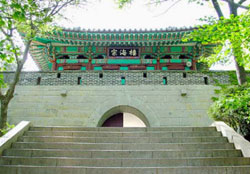Jeondeungsa Temple is an old temple situated on Mt. Jeongjoksan. Monk Adohwasang of Goguryeo established this temple, and when Queen Jeonhwa during the reign of King Chunryeol (reign 1274~1308) donated a jade lantern to the temple, it was renamed Jeondeungsa Temple.

History
Throughout the Silla and Goryeo dynasties, many temples erected in Ganghwa. However, most of them burned down or were destroyed, with only Jeondeung-sa (temple) along the Jeongjok Mountain Fortress Wall surviving well. The fortress includes a number of interesting buildings. In 1259, during the reign of King Gojong (r.1213-59) of Goryeo, a palace was built here. In 1660, the first year of the reign of King Hyeonjong (r.1659-1674) of Joseon, the government built an archives here for the preservation of the royal chronicles. There is also a monument commemorating the defeat of French naval invaders by General Yang Hyeon-su in 1866.
The temple lies in Sangnang-seong (also known as Jeongjok Sanseong), said to have been built by the three sons of Dangun Wanggeom, the founder of the Korean nation. According to legend, Adowhasang (a famous monk during the Goguryeo Dynasty) built a temple here and named it Jinjong-sa. After princess Jeonghwa (during the reign of King Chungnyeol of the Goryeo Dynasty) donated a bead lamp to the temple, it was renamed Jeondeung-sa.
The surrounding fortress was built from stones found in the area and is 2,944 meters long. Originally, none of the four gates had a watch tower. In 1739, during the reign of King Yeongjo (r.1724-1776), the South Gate was renovated and had a watch tower added. The gate was repaired in 1976. The temple grounds contain several interesting sites: Daeungbo-jeon (where Buddha is seated), Yaksa-jeon (where the Yaksa Buddha is seated), a copper bell, a gingko tree which does not bear fruit, and 104 wood printing plates for the Sutra of the Lotus (the complete collection of Buddhist Scriptures). Both Daeungbo-jeon and Yaksa-jeon have been designated treasures.
Located near Ganghwa-eup, this historical temple is popular among visitors and has several legends associated with it. The four corners of the eaves of Daeungbo-jeon have sculptures of a nude woman. According to one legend, a carpenter named Dongnyang fell in love with a woman while working on the temple and entrusted all his money to her. Before the completion of the temple, she eloped with another man and took all of Dongnyang's money. Upset by this, Dongnyang sculpted her likeness into the roof supports, forcing her effigies to repent by listening to the Buddhist invocations from inside the temple.
Gingko Tree Bearing no Fruit
In the front courtyard of Jeondeung-sa stands a 600 year-old gingko tree, which previously bore many gingkoes. According to one story, a greedy new mayor levied too much money on the local people. The head monk prayed for the tree to bear enough fruit to pay the higher tax. One day the sky became dark with rain. Lightning set fire to the tree. Since then, the tree has never borne fruit. The tree has several scorched spots and serves to remind people who are tempted towards greed.
Daeung-jeon (The Main Hall) (Treasures #178)
Daeung-jeon This hall was damaged by fire in 1605 then completely burned down in 1614. Reconstruction work began the next year and completed several years later. Temple annals record that the hall was reconstructed by a donor named Gyuyeong in 1855, the six year of King Cheoljong (r.1849-63) of the Joseon Kingdom (1392-1910). The hipped and gabled roof, round pillars, multi-bracketing and ornate eaves are typical of structures of that period. Of special note are the images at each corner of eaves.
Iron Bell of Jeondeung-sa (Treasure #393)
Iron Bell of Jeondeung-sa According to the inscription on the bell, it was made at a Chinese temple called Chungmingsu near Sinwuhsien, Hwaichow, in 1097 (during the Northern Sung period). Japanese troops took it during World War II and stored it in a warehouse in Bupyeong. After the war, a devoted Buddhist found the bell and brought it back to this temple. The only Chinese bell designated a Korean treasure, it is valuable for the study of Chinese iron bells. The bell is 1.64 meters high and 1 meter in diameter. The surface is divided by vertical and horizontal lines into eight sections which are inscribed with details as to the craftsmen and workers who did the casting. It also contains a 27-word description of the place where the casting was done. The bell is topped by twin dragons, the heads of which are encircled with 16 lotus petals. The mouth of bell is scalloped and there is a simple stripe around it.
Yaksa-jeon Hall (Treasure #179)
Yaksa-jeon It is not clear when this hall, which is dedicated to Yaksa-yeorae (the Buddha of medicine), was constructed. The only available record notes only that the roof tiles of the hall were replaced during the 13 the year of King Gojong (1876). The multi-bracketed eaves, hipped and gabled roof, rectangular and dressed stones of the platform-like foundation, and the tapering pillars are all typical of structures built during the middle of the Joseon era (1392-1910). However, the flat beams that usually accompany the tie beams in this kind of structure are missing.
Address
635, Onsu-ri, Gilsang-myeon, Ganghwa-gun, Incheon, SOUTH KOREA.



